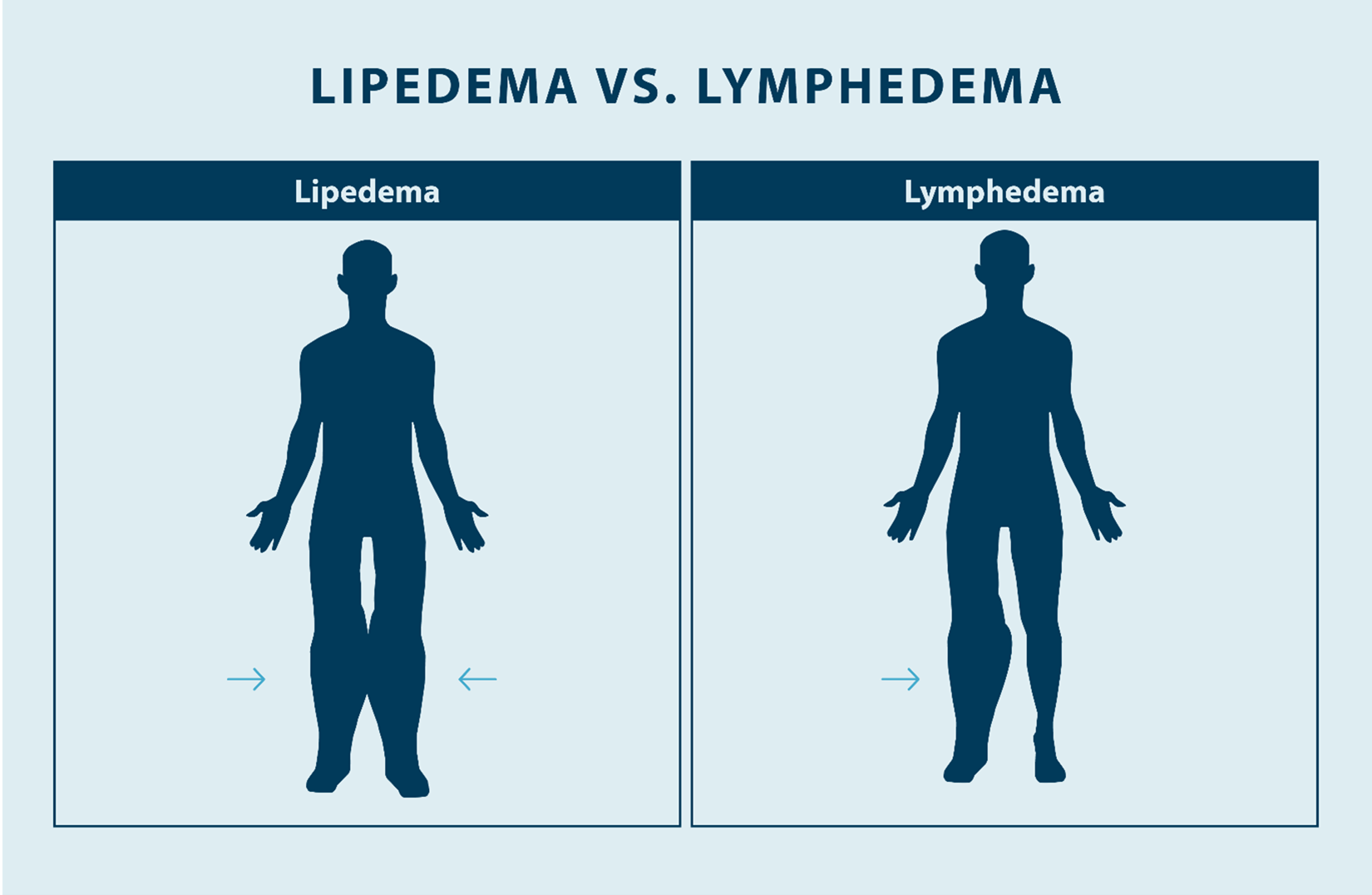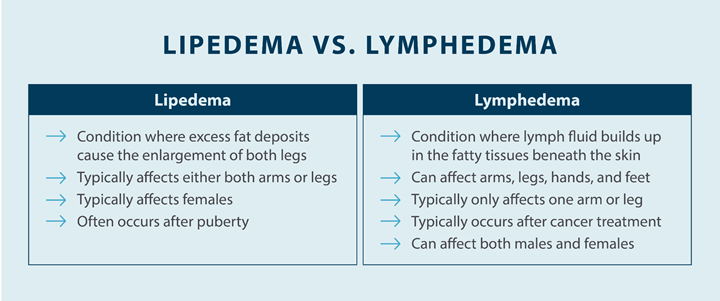Lipedema Guide: Causes, Symptoms, Treatments, and More


Lipedema is a disease that occurs when there’s a buildup of fat beneath the skin, which causes an enlargement of certain parts of the body as well as pain. While lipedema is relatively rare, it’s important to know the signs and symptoms. Here’s what you need to know about lipedema, its causes, symptoms, and more.
What Is Lipedema?
Lipedema occurs when there’s a deposit of fat just beneath the skin, which typically occurs in both legs. Lipedema can be characterized as a loose connective tissue disorder, and most patients living with lipedema experience pain and edema. Unlike normal fat growth, these fat deposits appear in unnatural areas and may be uneven. As fat deposits under the skin cause enlargement of your legs or arms, you’ll also notice that your skin becomes more susceptible to bruising.
Lipedema can be confused with lymphedema and other similar conditions. To make matters even more complicated, medical experts don’t fully understand what can cause lipedema. If you notice unnatural fat deposits and an abnormal enlargement of your legs or arms, you should visit a doctor for a diagnosis right away.
Lipedema can worsen if left untreated, which can eventually lead to complications such as pain and a lack of mobility. In order to diagnose lipedema, a doctor will evaluate your symptoms and use imaging studies to look for health conditions associated with lipedema, such as chronic venous insufficiency or specific tissue changes that may indicate the disease. However, in some cases, a doctor may use ultrasounds and MRIs to locate fat buildup, while a lymphangiogram or lymphoscintigraphy can help rule out lymphedema. These methods are also used to help diagnose or rule out other conditions seen together with lipedema to ensure patients can get all necessary interventions. Your doctor may also discuss hormonal changes you may be experiencing, as these are thought to be a contributing factor in lipedema. Getting a diagnosis as soon as possible is an important part of minimizing symptoms and making it easier to live with lipedema.
What Causes Lipedema?
Currently, medical professionals are unsure of what causes lipedema. However, the Lipedema Foundation states that lipedema can start during puberty, pregnancy, or other times of hormonal change, which suggests that these hormonal changes could play a role. Some medical experts also believe genetics may play a factor in lipedema cases, but more research is needed to support this claim.
Because lipedema is more common during periods of hormonal change, diagnosis can be easier if you’re experiencing symptoms during these times. If you notice weight gain or any symptoms, bring them up with your doctor. The primary focus is on treating lipedema and reducing the physical and cosmetic effects to make it easier to live a happy, healthy life.
What Are Symptoms of Lipedema?
If you think you may have lipedema, it’s important to know which symptoms you should watch out for. Here are some of the most common symptoms of lipedema:
- Abnormal deposits of fat in both legs where the legs are disproportionately large when compared to a relatively normal-sized torso
- Bruising more easily than normal
- Pain in the affected area
- Loose skin
- Unaffected by caloric intake or diet

These symptoms are similar to the symptoms of lymphedema, but typically appear during puberty, pregnancy, or menopause, and the fat deposits tend to progress with time. Over time, lipedema may also work its way up your body to affect the chest, torso, abdomen, and arms. However, in lipedema cases, legs usually remain disproportionately larger than other areas of the body. While there is no cure for lipedema, you can take steps to manage your symptoms to relieve pain and discomfort.
Oftentimes, the symptoms of lipedema can be mistaken for other conditions that can cause you to bruise more easily, and pain can be a result of an injury or illness. Loose skin can also be a sign that you’ve lost weight recently, which can be mistaken for lipedema. However, it’s important to visit a doctor if you’re experiencing any of these symptoms, especially if these symptoms began during a period of hormonal change.
Are There Treatments for Lipedema?
Much like lymphedema treatment solutions, lipedema treatment focuses on reducing the severity of symptoms and preventing progression. Fortunately, there are several at-home lipedema management solutions that can be prescribed by your doctor to treat symptoms such as swelling and pain.
At Tactile Medical, we offer lipedema management solutions that you can use from the comfort of your home. With both full-leg and half-leg garments, you can direct lymph fluid straight from your toes to the top of your thighs or knees to reduce swelling and provide relief. Your doctor might also recommend Tactile’s Flexitouch System, which is an advanced pneumatic compression device. Mild, dynamic pressure is delivered in 1-3 second intervals, creating a gentle “work and release” action that stimulates your lymphatic system to help reduce the symptoms of lipedema.
Your doctor or lipedema specialist can also provide recommendations on how to manage your symptoms. Making lifestyle changes is one of the best things you can do to reduce the effects of lipedema on your body. By making tweaks to your lifestyle, such as incorporating more exercise and eating more nutritious foods, you can help slow the progression of lipedema symptoms. Emotional support is also an important part of dealing with lipedema, especially if the changes in your body have taken a toll on your mental health.
In some cases, you may have an existing health problem that’s also contributing to swelling in your legs. If this is the case, it’s important to treat this underlying health condition in addition to focusing on reducing the severity of lipedema symptoms.
Complete decongestive therapy (CDT) is one of the most common treatment options for lipedema. This therapy involves techniques such as lymph drainage, compression therapy, and mobilization to help reduce the enlarging of your legs and manage pain and other symptoms. If this treatment isn’t effective, you may need to talk to a medical expert about surgery for lipedema. By using liposuction and excision, a surgeon can remove some of the built-up fat deposits in your body.
Lipedema vs. Lymphedema
Lipedema can be mistaken for other disorders in some cases. One of the conditions that lipedema is most commonly mistaken for is lymphedema because both of these diseases can cause similar enlargement of the extremities. Understanding the differences between lipedema and lymphedema is an important part of making sure you’re getting the right treatment. However, this can sometimes be challenging, as patients with lipedema can also have lymphedema.

Luckily, there are some key differences that typically distinguish lipedema from lymphedema:
- Lymphedema typically affects one arm, leg, hand, or foot, but usually occurs in the legs
- Lipedema is characterized by easy bruising and can affect both legs or arms, and usually spares the feet
- If both limbs are affected, the amount of swelling may be different in each limb with lymphedema
- The swelling in lymphedema is caused by a buildup of fluid rather than fat deposits
- Pressure will leave a small, temporary mark on your skin, known as pitting edema, if you have lymphedema, but not lipedema. However, people with lipedema can have lymphedema, so pitting edema can occur
- Lymphedema comes with an increased risk of infection
Unlike lipedema, lymphedema causes enlargement of an extremity like an arm or leg as a result of built-up lymph fluid, not fat deposits. This buildup of fluid is caused by an obstruction somewhere in the lymph system, whether it’s an absent or damaged lymph node or a problem with a lymph vessel. If you let this lymph fluid build up too much, you can suffer sepsis, skin infections, and other symptoms.

One thing to consider with lymphedema is that this condition typically has a known cause. Lymphedema can occur when there is damage to the lymphatic system. For example, if a lymph node is removed during cancer surgery, that can lead to lymphedema in that part of the body and adjacent trunk region. Lymphedema can also be caused by a buildup of scar tissue in the lymph system as a result of repeated radiation therapy, or from a cancerous tumor growing to the point that it’s obstructing your lymph system. Additionally, lymphedema can be inherited or present at birth.
Tactile Medical offers both lower body lymphedema solutions and upper body lymphedema solutions, which can be used to manage and treat both lipedema and lymphedema symptoms.
Conclusion: What Is Lipedema?
Lipedema is a condition that can cause excess fat deposits in your legs. While there is no current cure, there are ways to get relief from lipedema and lymphedema. Tactile Medical’s Flexitouch System are excellent for managing lipedema in your lower body right in the comfort of your home. Our lipedema solutions can be prescribed by your doctor and don’t require medications or the need for surgery. If you’re suffering from lipedema or lymphedema, you should visit a doctor to discuss a treatment plan to manage your symptoms.